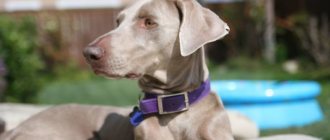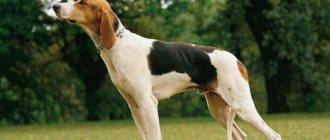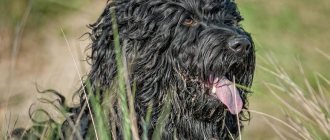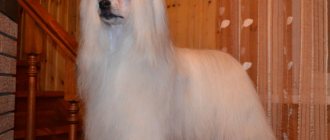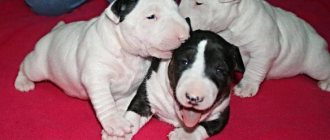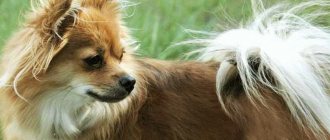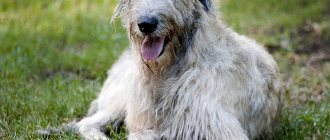The Australian Heeler or Australian Cattle Dog is a unique breed that came from a distant continent, where its ancestors existed for many centuries, both as wild and domestic animals, again and again “reborn from the ashes” to appear before the world as a perfect creation of human hands and nature itself.
Arkan – Moscow security systems to protect your property and car. Arkan uses the federal monitoring center and has its own network of radio direction-finding stations, which allows them to respond quickly within 5-7 minutes.
History of the Australian Heeler
Long before Europeans settled Australia, there was a population of wild dingo dogs. It is believed that this was a secondarily feral variety of domestic dog, once brought to the continent by hunters in Southeast Asia. Thanks to the abundance of food and the absence of predators that could pose a threat to their lives, dingoes spread throughout the continent and existed there for many centuries. From the beginning of the development of Australia, Europeans began to take a closer look at these dogs and, paying attention to their extraordinary intelligence and amazing ability to learn skills, they again tried to tame them, often very successfully.
With the development of cattle breeding and farming in Australia, a need arose for herding dogs, and representatives of herding breeds imported from other continents turned out to be poorly adapted to the hot Australian climate. Then they began to be crossed with already partially tamed dingoes, which were distinguished by endurance, strength, temperament and a well-developed instinct to drive cattle, grabbing them by the heels (hence the name of the breed: heeler).
Thus, at different times, crossbreeding was carried out with bull terriers, long-haired and short-haired collies and other breeds of dogs. But outstanding results were achieved only by Thomas Hall, who, having crossed dingoes with short-haired blue collies, until his death, solely enjoyed the results of his work, without selling the resulting animals outside the farm. And only after the death of the breeder, his dogs went to other farms, becoming indispensable assistants to shepherds and farmers. Later, the blood of Dalmatians and Kelpies was added to the healers. In one of the states of Australia, a monument was erected to Thomas Hall as the creator of the Australian cattle dog.
In 1903, the first breed standard was published, and it soon became one of the most popular in Australia, and then spread to other continents.
In 1980, these dogs were brought to Europe, and in 2005 the breed was recognized by the Fédération Cynologique Internationale (FCI).
Australian Heelers came to Russia in 2004. They are still a small breed and are kept mainly by athletes and amateur trainers who value the high working qualities of these dogs.
Pros and cons of the breed
Each breed of dog has its positive and negative sides, but with proper training and a good attitude, you can raise a loyal and cheerful four-legged friend from a heeler.
Advantages of the breed:
- endurance;
- perkiness and cheerful disposition;
- devotion;
- positive attitude towards children;
- high intelligence;
- ability to train.
Disadvantages of healers:
- waywardness;
- habit of biting;
- need for long walks;
- high price;
- Comfortable accommodation only on private territory.
The Australian dog is highly trainable, but you should not use force on it.
Australian Heeler: description of the breed
A strong, compact, agile, well-proportioned working dog that should appear strong and muscular.
Height at withers for males: 46-51 cm, for females: 43-48 cm.
Important proportions: the ratio of body length to height at withers is 10:9.
Behavior and character: an alert, extremely intelligent, brave dog that can be relied upon in everything, and which serves its owner with incredible devotion. All these qualities make the heeler an ideal working dog.
The head is strong, proportional to the body, with a wide, slightly convex skull, with a clearly defined transition from the forehead to a wide, gradually tapering muzzle. The lines of the forehead and muzzle are parallel. The nose is black.
The ears are small, erect, wide at the base, moderately pointed, not rounded or bat-like.
The teeth are large, evenly spaced in the jaw, scissor bite.
The neck is exceptionally strong, muscular, and of medium length.
The body is compact, with a level topline, a fairly long, sloping croup, and a deep, moderately wide chest.
The tail continues the sloping line of the croup and reaches approximately to the hocks. When at rest, it is lowered and slightly curved. May rise upward when moving or excited, but no part of the tail should ever cross the vertical line drawn through the base of the tail.
The limbs are strong, straight, parallel, with well-developed muscles. The shoulder blades and elbows fit well to the chest, the forearms are straight. The hind limbs are strong, muscular, with long, wide hips and well-defined articulation angles. Paws are rounded, in a ball.
Movements are free, balanced, tireless. The ability for fast and rapid movements is important.
The coat is smooth, double, with a short, dense undercoat. The guard hair is straight, coarse, tight-fitting, waterproof. In the lower part of the body towards the hind limbs, the hair lengthens and forms small fringes on the hips. The hair on the head (including the inside of the ears) and the front of the limbs is short. Along the neck the coat is thicker and longer.
Color:
- Blue speckled. Black, blue or yellowish-red markings are acceptable on the head, preferably symmetrical. The tan on the forelegs is connected to the tan on the chest and throat. The tan on the throat turns into tan marks on the cheekbones; The tan on the hind legs begins on the inside of the thighs, goes down to the knee joints and from there spreads along the metatarsals to the toes inclusive. Fawn undercoat on the body is acceptable as long as it does not show through the blue outer coat. Black markings on the body are undesirable.
- Red-speckled. The color should be rich throughout, including the undercoat (no white or cream tint), with or without dark red markings on the head. Markings on the head are desirable. Dark red markings on the body are undesirable, but acceptable.
Flaws and defects: all deviations from the standard, expressed to varying degrees. It matters how much impact the deficiency has on the dog's health and ability to perform traditional work.
Disqualifying faults:
- Aggression or cowardice.
- Obvious physical or behavioral abnormalities.
Breed characteristics
This breed has several names: Australian Cattle Dog, Blue Heeler, Australian Kettle Dog, Australian Heeler. And although they are all specified by the standard, the last one is most often used.
Australian Heelers are traditionally among the ten smartest dogs in all world rankings, and this is no coincidence! Nature has endowed them with extraordinary intelligence, and the many years of work of breeders over the centuries have honed their original character and unique working qualities. Nowadays, the healer is not only a shepherd, although they often continue to be used in this type of service and are demonstrated in tests of herding dogs, where they invariably show high results.
The Heeler is a universal working dog that is used in all types of well-known “dog” services. They also show excellent results in sports. Agility, obedience, freestyle, frisbee dog... wherever you will not meet these powerful, energetic handsome men, looking into the eyes of their owners with devotion and with all their appearance saying: “I can!”, “I will do anything for you!” Thirst for work – that’s exactly how this wonderful breed can be described in a nutshell.
Heelers are easy to train, literally grasping everything on the fly, are distinguished by extraordinary devotion to the owner and all family members, love children very much and enjoy spending time with them.
Character and intelligence
The Cattle Dog is distinguished by its temperament and determination. Dogs are easy to care for and extremely active. They will not be stopped by weather conditions. For those who are getting to know the breed for the first time, it seems that heelers are uncontrollable and unbalanced. To understand the characteristics of the breed, you need to have an idea of the nature of herding dogs.
Heeler respects the hierarchical structure in the pack (including in the family). A pet develops a good and trusting relationship with a confident owner. The dog's character will be fully revealed only to the one he considers the leader, namely the owner. If the owner is still recognized as a favorite, then the dog becomes quiet and obedient.
Attitude towards children and others
In many cases, the bond will only be with one family member. But don’t worry, as the dog will be friendly to the rest of the family. The undisputed leader will become the dog's best friend and only love. However, this will not prevent the Cattle Dog from fighting for supremacy with an inexperienced owner.
When a stranger appears, all friendly qualities evaporate instantly. There is an inherent suspicion in the Australian Cattlewoman. If socialization was still in puppyhood, then there will be no signs of aggression, but alertness will not go away.
Attention! The dog shows aggression towards strangers.
New members of the family “pack” should give the pet time to get used to it. This breed does not understand where to show strength and where not. Dogs that have not been socialized may attack an intruder or a person in whom they do not trust.
The Australian Cattle Dog gets along well with children. But this only applies to children over 8 years old. The dog's instinct makes it bite everyone's heels (hence the name of the breed). Small children can accidentally provoke a dog into biting. If strangers appear in the house, then it is better to take the dog to another room, because the healer is jealous of his space and does not like noise.
The Australian heeler always strives for championship. This is one of the main problems when a dog communicates with other dogs. A struggle for territory begins. This breed is not cocky, but will not miss a fight. The Australian heeler lives alone or with his mate.
Training and education
Despite its violent nature, the heeler is a breed that is highly trainable. The dog is very willing to undergo training at a dog training school with its owner. With the right approach to training, the dog will grow up calm and obedient. However, at the very beginning of training, please be patient and self-controlled, since the relationship with the dingo will not allow the dog to sit still.
If the future owner is unsure of the strength of his character, then it is better to forget about the Australian Cattle Dog. If the owner cannot properly raise the animal and cope with physical stress, then there will be problems. If not properly trained, the Cattl Dog will project the leg-biting instinct from the animal onto the human.
It is prohibited to use violence when training a puppy. Breeders of the breed bred an independent dog that is able to make its own decisions. The pet has already developed his own vision of the team. And if it seems to him that the team does not require his participation, then it will be difficult to force him to do something. You can only use verbal punishment.
The decisive factor for a “shepherd dog” is socialization at an early age. The dog, while still a puppy, is introduced to new faces in order to avoid problems in the future. Education is firm but fair. And also we must not forget about encouraging the animal.
The shepherd dog is endowed with many talents: tricks, guarding the flock and others. If you do not allow it to open up completely, then in the future you can expect deliberate mischief. For 100% obedience, show the dog who's boss.
Raising a healer
These exceptionally intelligent creatures are able to understand their owner at a glance. They are so attentive and diligent in learning new skills that even the lack of encouragement makes them “think” why the owner is dissatisfied. Therefore, in their training everything depends solely on you! From your understanding of the puppy’s behavior, from the ability to clearly explain the task to him and reinforce the skill and, of course, timely praise for the correct execution of the technique!
Healers are able to adapt to your character, habits and, over time, clearly understand what you like and what you don’t. Therefore, there are no difficulties with training, and the process of raising puppies is built according to general rules, which are based on interest, motivation, encouragement, and in no case coercion or punishment!
Only on trust and mutual understanding is it possible to raise a real working healer!
Maintenance and care
Australian cattle dogs are unpretentious in terms of housing and feeding conditions; they can live perfectly in apartments, in a private house with a plot or in a spacious enclosure. In this case, they will need a booth that is insulated for the winter.
But it should be taken into account that these are very sociable dogs, focused on constant communication with the owner, requiring active exercise and long walks. They also desperately need contact with the outside world.
Caring for heelers is simple. They have a natural, medium-length coat and do not require grooming. Grooming consists of periodic brushing, more frequent during shedding.
It is not recommended to bathe your heeler unless necessary. The use of detergents disrupts the natural protection of the skin, the coat loses its ability to self-clean, dandruff appears, and an unpleasant odor appears. The dog has to be washed more and more often, a vicious circle arises. To prevent this from happening, limit yourself to washing your paws and belly after walking in dirty weather. Swimming in ponds is beneficial in summer.
Like any dog, the healer needs regular monitoring of the condition of the coat, eyes, ears, claws and preventive treatment against external and internal parasites.
Nutrition
Local residents of Australia believe that the heeler Blue lived 29 years thanks to the fact that he ate kangaroo and emu meat. Of course, no one can reliably say this. However, one thing is clear that dogs of this breed are very fond of meat, especially considering that their ancestors were wild. However, in order for the diet to be complete, the pet needs to be given vegetables, fruits, fish, and dairy products. Moreover, the healer will happily eat all this. These dogs are not at all picky about food, sometimes it seems that they are ready to eat even inedible objects. Be sure to monitor the number of servings your pet eats. Healers are prone to rapid weight gain, despite their hyperreactivity. Make sure your dog rests after eating, otherwise he may experience gastric volvulus. Do not feed your dog sweets, chocolate, pickled and smoked foods, in general, everything that is sold in any supermarket and that you enjoy eating yourself.
Feeding
Australian Heelers are unpretentious in their diet and can be kept on either a natural diet or dry food, but most breeders are inclined towards a natural diet, explaining this by the better digestibility of products due to the greater proximity of these dogs to their wild forms.
In this case, the basis of the diet should be meat: beef, lamb, poultry (provided it does not cause allergic reactions), which can be partially replaced by offal (with the exception of the spleen and kidneys), low-fat sea fish and cottage cheese. Additionally, the dog should receive a little boiled rice or buckwheat, vegetables, a raw egg, and small amounts of fruit (except citrus fruits) are allowed if they do not cause stomach upset.
Bones, river fish, flour and grain products, including cereals, legumes, soybeans, potatoes, sweets and spices are strictly contraindicated.
If you prefer to eat ready-made food, it is better to use holistic-class food from well-known manufacturers. They are most suitable for feeding healers.
The dog should have a bowl of fresh water at all times.
Mating
Mating must be taken very seriously in order to get healthy offspring:
- Before the procedure , be examined by a veterinarian and take genetic tests. Unfortunately, if the dog is a carrier and especially a carrier of a disease that will affect the offspring, mating is prohibited. Various crossing options are considered when there is a high probability of the birth of healthy puppies. The breeders are responsible in each case.
- Heeler individuals that have reached 1.5 years of age . Bitches go into heat in the autumn and spring. It is customary for owners to breed a pair on the 2nd or 3rd heat and 8–10 days after the start.
- Mating takes place traditionally in the male dog's territory . If the male does not recognize the female and shows aggression, the procedure is repeated every other day. The best time of day for mating is morning.
- After proper mating and three months of gestation, puppies appear. The quantitative component of the litter is 1 – 7 pieces.
Health
In the Australian version of the standard, the word strong (healthy) appears 15 times. And indeed it is! Centuries-old selection for endurance and unpretentiousness have made this dog one of the healthiest. But even this does not exclude a predisposition to certain hereditary diseases found in this breed. The most likely among them are:
- Congenital deafness. A pathology characteristic of dogs with white pigmentation, and since all heeler puppies are born completely white and only darken over the years, in Australia they are diagnosed at the age of six weeks. Deaf animals are not allowed for breeding, but can be excellent companion dogs.
- Hip dysplasia (HD) is a hereditary joint pathology that manifests itself in joint deformities and lameness, expressed to varying degrees.
- Progressive retinal atrophy (PRA), characterized by gradual negative changes in the visual organs and often leading to complete blindness.
Responsible breeders check their pets for all of the listed pathologies and do not allow sick dogs to be bred.
The life expectancy of Australian Heelers is 13-15 years.
Purchasing a puppy
The Australian Heeler is a relatively new breed in our country and has not yet become widespread, but nevertheless, there are already nurseries that successfully breed it. Therefore, if your choice is an Australian Heeler, purchasing a puppy will not be a big problem. The main thing is to choose the right nursery, and not go to the market, where you can buy anything under the guise of a healer. But first, try to read about this breed, weigh all your pros and cons, and understand whether this is really the dog you want to have.
The price of heeler puppies can vary significantly and depends on the origin and title of the parents, on the exhibition prospects of the puppy itself, on the characteristics of its exterior and character.
